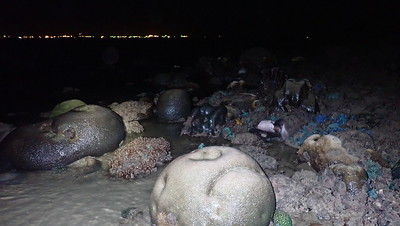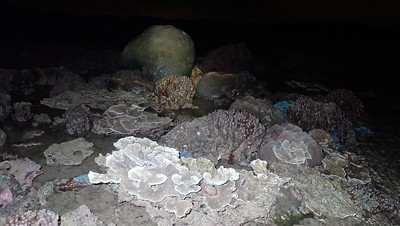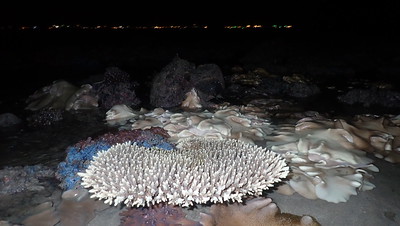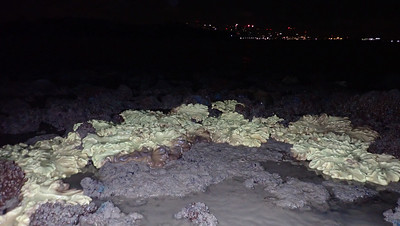Today, I estimate about 5% of the hard corals that I saw are bleaching, with an additional 20% showing stress (paler than usual or with bleaching portions) or with recently dead patches. Some parts of this shore have large patches of leathery soft corals. About 5% of these were outright bleaching (white), while about 40% were more yellow than usual. The situation wasn't as bad as what I saw during mass coral bleaching in 2016.
While a few of the large coral colonies were bleaching or pale, most were alright. Here's some near the seawall at the mouth of the lagoon.
A look at those near the reef edge.
I still saw some colonies of Plate montipora corals. Most were alright and only a few were bleaching. Sadly, I didn't come across The huge colony of Boulder horn coral that I saw on our last survey in Aug 2019.
There are some Acropora corals here and some are bleaching but others are still nice and brown.
Some hard corals like Acropora coral harbours small animals that can't live anywhere else. Like the Acropora goby. I saw several of these gobies but couldn't take good photos of them.
There are a lot of large leathery soft corals outside the seawall. About 5% were outright bleaching (white), while about 40% were more yellow than usual. Many were alright.
Bleaching leathery soft coral (left) next to a healthy one (right).
Inside the lagoon, only a few hard corals were bleaching. In many, the lower portions were alright and only the top part was bleaching or recently dead.
Most colonies were alright although many had recently dead portions.
The field of Branching montipora corals inside the lagoon is still doing alright. Most of the colonies appear to be alive and well.
Some of the other kinds of corals among the Branching montipora corals, however had yellow or bleaching portions.
The huge colony of Anemone coral inside the lagoon is still there. It wasn't outright bleaching, but it seems most of the uppermost portions of the colony is recently dead.
The situation today is a lot better than what I saw during the mass coral bleaching in Jul 2016. At that time, I estimated about 50% of the hard corals and 50% of the leathery soft corals are bleaching. And about 5-10% of corals have died recently. This is what we saw outside the seawall at that time.
 |
| Mass coral bleaching at Kusu Island in Jul 2016. |
In comparison, this is what I saw in Jul 2106.
 |
| Bleaching corals from the jetty seen in Jul 2016. |
Today, I saw a few Giant carpet anemones. One was partly bleaching, another was rather pale, but the rest were alright. There seems to be more Magnificent anemones than usual, they were all fine. And I saw three different body column colours: white, red and purple.
I saw several clumps of Asparagus flowery soft corals. they were alright - purple or orangey. I saw a few small clumps of Button zoanthids bleaching, and some large patches of Sea mat zoanthids bleaching.
I focused on checking the corals so didn't really look out for animals. But I did see some that are commonly encountered on our reefs: like the White-rumped sea cucumber and an Arabian cowrie. The sandy areas had many Cake sand dollars and a few Common sea stars. Snapping shrimps, hermit crabs and crabs were also busy on the shore.
Richard came across a Fluted giant clam!
And Jianlin came across TWO cone snails, here's one of them.
Inside the lagoon, there were sprinkles of Spoon seagrass (tiny leaves) and Needle seagrass (narrow leaves) in the lagoon. I didn't come across any Haddon's carpet anemones.
Richard checked out the southern side of Kusu and saw long Tape seagrass.
There is still a bloom of Ulva seaweed in the eastern corner of the lagoon. Fortunately, we did not come across any fish traps or nets on today.
This rich shore lies just opposite the Central Business District and only takes a few minutes by fast boat to reach. Unfortunately, most of our survey was done in the dark as the tide turned at sunrise.
The cluster of Kusu, Lazarus and St. John's Islands has been recommended by the Singapore Blue Plan 2018 for elevated protection status.
The Blue Plan highlights that Lazarus, St. John’s, and Kusu Islands are established sites for coral nurseries as their shoreline offers ideal sheltered areas for growth of corals. Designating these islands as No-fishing Areas can bolster their rehabilitation. Protecting a larger cluster of islands means zonation plans for use can be implemented to manage tourism and human impacts.
DOWNLOAD the Plan, SUPPORT the Plan! More on the Singapore Blue Plan 2018 site.
Posts by others on this survey
Richard Kuah
Jianlin Liu
Dayna Cheah
Vincent Choo
Other surveys on our shores
Marcus Ng checked out Changi
Loh Kok Sheng surveyed a reefy East Coast wall.
Jonathan also surveyed the same reefy East Coast wall
Vincent Choo surveyed another part of East Coast Park the day before





















